

iOS SDK vs Android SDK. IOS SDK and Android SDK are 2 great operating systems but it seems that are some diferents between IOS SDK and Android SDK.I think that Android SDK is better than IOS SDK but it seems that not everybody thinks this way.As development tools, Android has an advantage (depending how you look) for IOS.
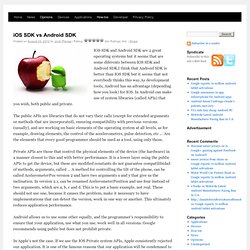
In Android can make use of system libraries (called APIs) that you wish, both public and private. The public APIs are libraries that do not vary their calls (except for extended arguments or methods that are incorporated), ensuring compatibility with previous versions (usually), and are working on basic elements of the operating system at all levels, as for example, drawing elements, the control of the accelerometers, pulse detection, etc … Are the elements that every good programmer should be used as a tool, using only those.
Private APIs are those that control the physical elements of the device (the hardware) in a manner closest to this and with better performance. In Apple’s not the case. Getting Started With Cross-Platform Mobile Application Development Frameworks. There are different mobile platforms available including iPhone, iPad, Android, Blackberry, Symbian and Windows Mobile and cross-platform mobile framework like Rhodes, Titanium, PhoneGap, and many more provide custom development services like intuitive user interface of the App for each platform to provide rich experience to a native application.
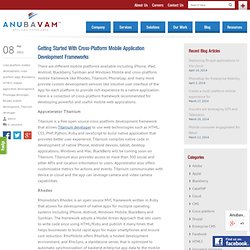
Here is a collection of cross-platform framework recommended for developing powerful and useful mobile web applications. Appcelerator Titanium Titanium is a free open source cross platform development framework that allows Titanium developer to use web technologies such as HTML, CSS, PHP, Python, Ruby and JavaScript to build native application that provides better user experience. Titanium compiles native code in development of native iPhone, Android devices, tablet, desktop applications, Windows and Mac. BlackBerry will be coming soon on Titanium. Rhodes PhoneGap MoSync Sproutcore Touch Sencha Touch.
Iphone - iOS Tests/Specs TDD/BDD and Integration & Acceptance Testing. What separates the iOS SDK from the Android SDK. How to build an Apple Push Notification provider server (tutorial) « Boxed Ice Blog. Mobile Devices and Rails: Maintaining your Sanity – metautonomo.us. The "mobile web" may look more like the web we know and love as devices get more powerful, but there will always be a place for a bit of customization in the name of improved UX on mobile browsers.
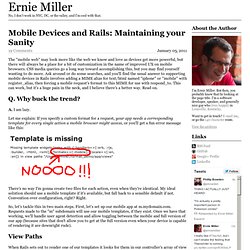
CSS media queries go a long way toward accomplishing this, but you may find yourself wanting to do more. Ask around or do some searches, and you'll find the usual answer to supporting mobile devices in Rails involves adding a MIME alias for text/html named "iphone" or "mobile" with register_alias, then forcing a mobile request's format to this MIME for use with respond_to.
This can work, but it's a huge pain in the neck, and I believe there's a better way. Read on. Q. A. Example of codes from real applications. Mobile Web Application Best Practices. Abstract The goal of this document is to aid the development of rich and dynamic mobile Web applications.

It collects the most relevant engineering practices, promoting those that enable a better user experience and warning against those that are considered harmful. Status of This Document This section describes the status of this document at the time of its publication. Other documents may supersede this document. This is the W3C Recommendation of Mobile Web Application Best Practices. Since publication as a Proposed Recommendation on 21 October 2010, the Working Group clarified that alternative compression formats (such as EXI) referred to in section 3.4.1 Use Transfer Compression may not share some of the impediments of common compression formats.
The document contains statements that may be regarded as forward-looking when this document is published (14 December 2010). Mobile Rails applications, part 1: An overview. August 22, 2010 I’ve spent some time over the last week learning more about creating mobile versions of Rails applications.
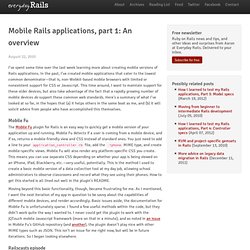
In the past, I’ve created mobile applications that cater to the lowest common denominator—that is, non-Webkit-based mobile browsers with limited or nonexistent support for CSS or Javascript. This time around, I want to maintain support for these older devices, but also take advantage of the fact that a rapidly growing number of mobile devices do support these common web standards. Here’s a summary of what I’ve looked at so far, in the hopes that (a) it helps others in the same boat as me, and (b) it will solicit advice from people who have accomplished this themselves. Mobile Rails applications, part 2: jQTouch with Rails 3. August 29, 2010 In my last post I shared my first steps toward creating a mobile version of a Rails application.
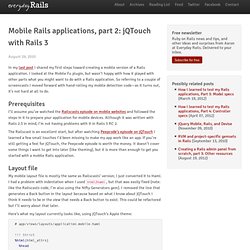
I looked at the Mobile Fu plugin, but wasn’t happy with how it played with other parts what you might want to do with a Rails application. So referring to a couple of screencasts I moved forward with hand-rolling my mobile detection code—as it turns out, it’s not hard at all to do. Prerequisites I’ll assume you’ve watched the Railscasts episode on mobile websites and followed the steps in it to prepare your application for mobile devices. The Railscast is an excellent start, but after watching Peepcode’s episode on jQTouch I learned a few small touches I’d been missing to make my app work like an app. Objective c - JSON and Core Data on the iPhone. jQuery Mobile.
HOW TO: Make Your Mobile Websites Act More Like Native Apps. This series is supported by Rackspace, the better way to do hosting.
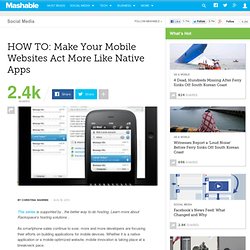
Learn more about Rackspace's hosting solutions here.